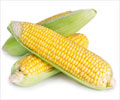The most comprehensive genetic analysis yet of corn genome has been completed by scientists.

The results should boost international efforts to increase yields, expand areas where corn can be cultivated and produce varieties better equipped to resist pests and disease.
Funded in the United States by the National Science Foundation (NSF) and the USDA, the work was a collaborative effort by scientists at 17 U.S. and foreign institutions that include the University of Wisconsin-Madison; University of Missouri-Columbia; North Carolina State University; Beijing Genome Institute; University of California, Davis and the International Maize and Wheat Improvement Center, Mexico City, Mexico.
"This work represents a major step forward and an important tool in the arsenal available to scientists and breeders for improving a vital source of nutrition," said Edward B. Knipling, administrator of USDA's Agricultural Research Service.
The analysis could also help those, who develop corn yields as a source of fuel, who manage crops in the face of changing climates and who are concerned about the diminishing supply of arable land and growing populations, he said.
"This project is a stellar example of how collaborations of scientists, here and abroad, leverage resources across multiple agencies to enable transformational research with the potential to address urgent societal needs for a bio-based economy," said John Wingfield, assistant director for NSF's Biological Sciences Directorate.
Advertisement
The studies' collaborators shed light on corn's genetic diversity, detail how it evolved and outline how corn-known as maize among scientists-continues to diversify as it adapts to changing climates and habitats.
Advertisement
Another study led by team member Jeff Ross-Ibarra from the University of California, Davis gives an extraordinary glimpse into how corn evolved more than 8,700 years ago from a wild grass in the lowland areas of southwestern Mexico into today's ubiquitous international commodity.
The researchers compared wild varieties with traditional corn varieties from across the Americas and with modern improved breeding lines. They identified hundreds of genes that played a role in the transformation of corn from its wild origins to today's cultivated crop and show how that transition was largely achieved by ancient farmers who first domesticated it thousands of years ago.
Last year, the economic value of the U.S. corn crop was $76 billion with U.S. growers producing an estimated 12 billion bushels, more than a third of the world's supply. Corn is the largest production crop worldwide, providing food for billions of people and livestock and critical feedstock for production of biofuels.
The studies results were published in separate reports in the June 3 issue of the journal Nature Genetics.
Source-ANI











